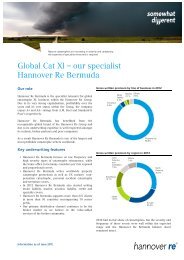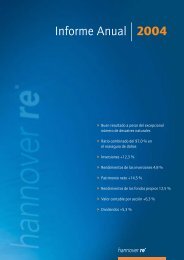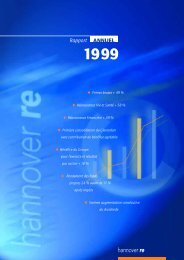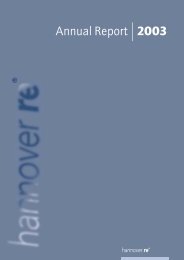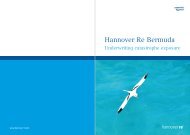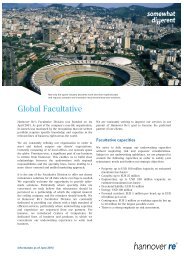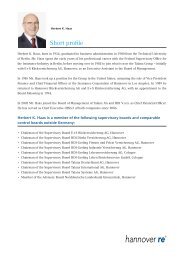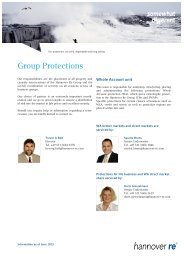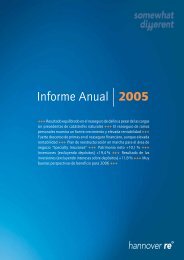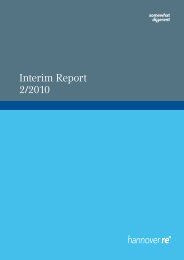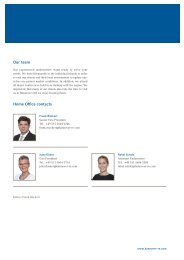Annual Report 2010 - Hannover Re
Annual Report 2010 - Hannover Re
Annual Report 2010 - Hannover Re
Create successful ePaper yourself
Turn your PDF publications into a flip-book with our unique Google optimized e-Paper software.
Rating structure of our fixed-income securities 1<br />
Rating classes Government bonds Securities issued by<br />
semi-governmental<br />
entities<br />
in %<br />
in EUR<br />
million<br />
in %<br />
in EUR<br />
million<br />
in %<br />
Corporate bonds<br />
in EUR<br />
million<br />
Covered bonds/assetbacked<br />
securities<br />
in %<br />
in EUR<br />
million<br />
AAA 83.9 4.830.5 61.2 3.261.6 3.3 207.2 72.9 2.951.8<br />
AA 4.4 249.6 34.8 1.852.1 21.0 1.326.1 15.5 626.9<br />
A 5.9 340.6 3.4 183.6 57.5 3.625.6 1.3 51.6<br />
BBB 5.2 298.9 0.5 25.7 14.8 934.9 2.9 116.1<br />
< BBB 0.6 35.3 0.1 6.0 3.4 214.0 7.4 299.5<br />
Total 100.0 5,754.9 100.0 5,329.0 100.0 6,307.9 100.0 4,045.9<br />
1 Securities held through investment funds are recognised pro rata with their corresponding individual ratings<br />
on these holdings. There is no risk of default here on account<br />
of bailout mechanisms existing on the European level (Eurozone<br />
safety net).<br />
On a fair value basis EUR 3,097.5 million of the corporate<br />
bonds held by our company were issued by entities in the financial<br />
sector. Of this amount, EUR 2,648.0 million was attributable<br />
to banks. The vast majority of these bank bonds<br />
(almost 91.3%) are rated “A” or better. Our investment portfolio<br />
under own management does not contain any directly<br />
written credit derivatives.<br />
Operational risks<br />
In our understanding, this category encompasses the risk of<br />
losses occurring because of the inadequacy or failure of internal<br />
processes or as a result of events triggered by employeerelated,<br />
system-induced or external factors. The operational<br />
risk also extends to legal risks. Operational risks exist, inter<br />
alia, in relation to the risk of business interruptions or failures<br />
of technical systems or they may derive from unlawful or unauthorised<br />
acts. Given the broad spectrum of operational<br />
risks, there is a wide range of different management and monitoring<br />
measures tailored to individual types of risk.<br />
Core elements of risk management – for example with an eye<br />
to business interruptions and the failure of technical systems<br />
– are our contingency plans. These are designed to ensure the<br />
continuity of mission-critical enterprise processes and systems<br />
(recovery plans, back-up computer centre). The flexible<br />
working model of alternating telecommuting adopted by <strong>Hannover</strong><br />
<strong>Re</strong> is, among other things, also a risk-minimising measure<br />
inasmuch as alternative workplaces and the requisite infrastructure<br />
are kept available on a decentralised basis. At the<br />
same time, we are thus able to offer the possibility of a healthy<br />
work/family balance. An important element of our human resources<br />
management policy, teleworking also reduces the risk<br />
of potentially losing key personnel by facilitating an attractive<br />
working environment.<br />
As far as possibly unlawful or unauthorised acts are concerned,<br />
we enable our staff and partners to report serious<br />
breaches of the law pertaining to <strong>Hannover</strong> <strong>Re</strong> anonymously<br />
through our electronic whistleblower system. The information<br />
provided is brought to the attention of <strong>Hannover</strong> <strong>Re</strong>’s Compliance<br />
Office so that it can investigate potentially suspicious<br />
circumstances. All tips are handled in the strictest confidence.<br />
The range of tools is rounded off with external and internal<br />
surveys of clients and staff, the line-independent monitoring<br />
of risk management by Internal Auditing and the internal control<br />
system.<br />
Other risks<br />
Of material importance to our company in the category of<br />
other risks are primarily emerging risks, strategic risks, reputational<br />
risks and liquidity risks.<br />
The hallmark of emerging risks (such as in the field of nanotechnology<br />
or in connection with climate change) is that the<br />
content of such risks cannot as yet be reliably assessed – especially<br />
with respect to our treaty portfolio. Such risks evolve<br />
gradually from weak signals to unmistakable tendencies. It is<br />
therefore vital to detect these risks at an early stage and then<br />
determine their relevance. For the purpose of early detection<br />
we have developed an efficient process that spans divisions<br />
and lines of business and ensured its linkage to risk management,<br />
thereby making it possible to pinpoint any necessary<br />
measures (e.g. ongoing observation and evaluation, the implementation<br />
of contractual exclusions or the development of<br />
new reinsurance products). This interdivisional and cross-line<br />
process is handled by an expert working group assembled<br />
specially for this task.<br />
68 Management report opportunity and risk report<br />
<strong>Hannover</strong> <strong>Re</strong> Group annual report <strong>2010</strong>



